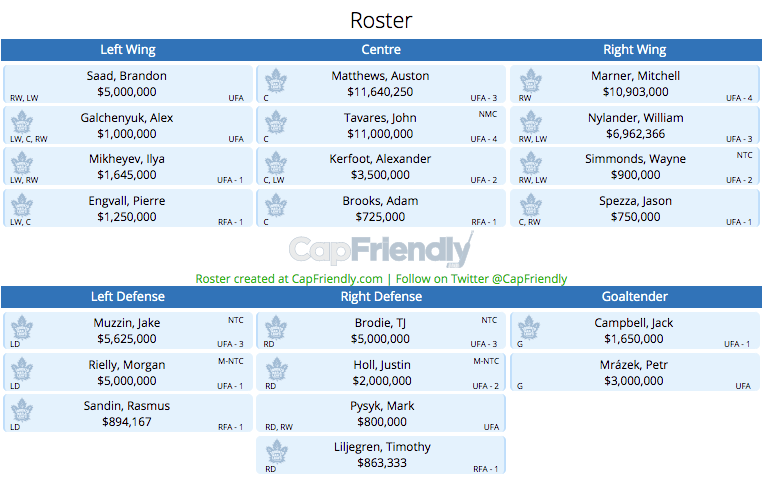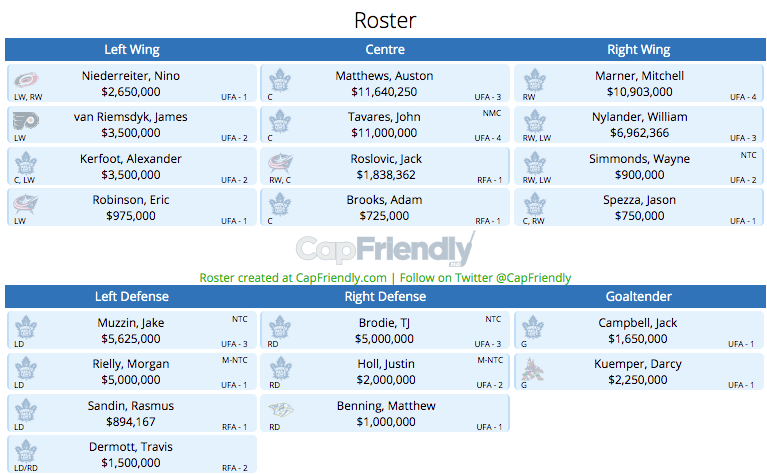The Maple Leafs have a fascinating offseason ahead of them.
With Zach Hyman set to sign in Edmonton, the Leafs have some serious work to do if they want to improve on last year’s roster, especially given their lack of cap space. This article will look at their primary needs, potential targets, and attempt to predict their offseason moves.
At this point, I don’t expect them to trade someone like Morgan Rielly or Mitch Marner. Whether they should or not is a different story, but for simplicity’s sake, I am assuming that their plan is to have both players on the opening night roster. If they do plan on making a blockbuster trade, everything changes — they suddenly have more options to consider.
However, let’s keep it as simple as possible for now and assume that both Rielly and Marner are on the team next season.
Primary Team Needs
1. A Second Goalie
With Frederik Andersen’s tenure likely coming to an end after five seasons, Jack Campbell needs a new partner. After his strong 2020-21 season, if the playoffs started today, the Leafs would have plenty of confidence in Jack Campbell as their Game 1 starter. However, he did struggle with injuries last season and his career-high in NHL games played is 31 back in 2018-19.
Campbell played 52 games for the Ontario Reign of the AHL back in the 2016-17 season, which was Andersen’s first season in Toronto. It’s awfully tough to pencil Campbell in for 50+ games next season, so expect the Leafs to look for more than just an average backup to supplement him. Campbell simply does not have the same track record as someone like Andrei Vasilevskiy or Connor Hellebuyck. It would be foolish to put all of their eggs in this one basket.
There is certainly a chance that Campbell battles injury next season and fails to play 40+ games. There is also a chance that he stays healthy but struggles. Leafs fans saw Frederik Andersen go from a goalie with a .918 save percentage every season to someone who struggled to get to .910. The recent seasons of netminders like Jacob Markstrom or Anton Khudobin are just the latest examples of how unpredictable goalie performance can be.
The Leafs need a 1B starter rather than a true backup. If Campbell struggles or gets injured, they should have confidence in this second goalie to be able to play game one of the playoffs. While Campbell was great last season, there is simply too much on the line to only have one quality option at the most important position in hockey.
2. A Replacement For Zach Hyman
Every Leafs fan knows that Hyman is a very good player. He made every line that he was on better with his ability to win puck battles and consistently tilt the ice in his team’s favour. There is little doubt that he’s a legitimate top-six winger. Replacing him won’t be easy, but his departure will leave a major hole in their lineup and the Leafs need to do something to help replace his production.
Secondary Team Needs
Adding a second goalie and a top-six winger are the first priorities. Once the Leafs fill those roles, they can see how much cap space is left and proceed from there. They cannot overspend on their secondary needs and then turn around and realize that they can no longer afford a top-six winger. Expect a few signings in the $1 million range to fill in these gaps.
1. A Zach Bogosian Replacement
Bogosian played well for the Leafs last season, but it sounds like he wants to play south of the border this year. The Leafs are looking for a defensive presence who can help them on the penalty kill and also pair nicely with Rasmus Sandin at 5-on-5. While they could open the season with Travis Dermott and Timothy Liljegren on the NHL roster, it sure sounds like Kyle Dubas wants to add a veteran depth defenseman to help replace Bogosian.
2. A Second Top-Six Winger
Zach Hyman’s replacement will likely play with Matthews and Marner, but the Leafs could also use someone to pencil in next to Tavares and Nylander. Given the Leafs’ cap situation, expect this player to be quite cheap.
Bringing back Alex Galchenyuk is a possibility, or they could promise former Soo Greyhound Michael Bunting a spot in the top-six similar to what they did with Jimmy Vesey last season.
Expect this player to come in around the $1-2 million range, although perhaps they could spend more if their other additions cost less than expected. There is also a chance that they sign a cheap third-line center and move Kerfoot to the wing, but it’s tough to find a good third-line center at a low cap hit.
3. Other Upgrades
There are plenty of other upgrades this team could look at, but it will likely come after they’ve filled their primary needs. They could upgrade on Adam Brooks as their fourth-line center, for example, or target a bottom-six winger like Nick Ritchie. They could also decide to sign someone like Alex Wennberg and move Kerfoot out subsequently.
However, these are all secondary needs for this team. Unless the Leafs find a deal that is too good to pass up, they’ll likely wait to see how much cap space they have left once they’ve addressed the bigger holes in their lineup.
Free Agency vs. Trade
Both the free agency route and the trade route offer their own tradeoffs. With free agency, the Leafs would not have to give up any prospects or picks to acquire the player, but this usually leads to a higher cap hit. With trade, the Leafs would have to give something to get something, but they could target underpaid players or pay extra for salary retention.
Ultimately, the Leafs will likely need to use both avenues.
The Free Agency Route
Given Toronto’s cap situation, it’s going to be difficult to address every need through free agency. Assuming they start the season with 12 forwards, seven defensemen, and two goalies on their roster, they have about $8.5 million to spend on a second goalie, Hyman’s replacement, and a second winger who can potentially play in the top six.
Perhaps they can get to $9 million or so by replacing one of Mikheyev, Engvall, or Dermott with a cheaper option, but either way, they aren’t going to be loaded with cap space.
A top-six winger is likely going to come with a cap hit of at least $4.5 million or so — probably closer to $5 million. A “1B” goalie will likely cost about $3-3.5 million.
Let’s pencil in about $1 million for someone like Alex Galchenyuk or Michael Bunting. The team would look something like this:
The above team is left with about $200k of cap space, with Travis Dermott traded in this example to make it all work (you could move Mikheyev or Engvall instead if you prefer). Perhaps they sign a Jaden Schwartz instead of a Saad, or a Bunting instead of a Galchenyuk, but this gives a good picture of what the team will look like through free agency.
This team is quite comparable to their roster from last year, but it could be improved by making trades.
The Trade Route
The trade route allows the Leafs to acquire underpaid players. They can maximize their cap space and put a better team on the ice, but it’s going to cost them picks and prospects. As an extreme example, the Leafs could theoretically trade for a young player on an entry-level deal like Quinton Byfield, but it would cost them an absolute haul of picks and prospects to do so.
Rebuilding teams like Columbus and Arizona are the most likely trade partners — all are looking to trade NHL players for futures. Players like Tyler Bertuzzi in Detroit, Eric Robinson in Columbus, Darcy Kuemper in Arizona, and Mason Appleton in Seattle are possible targets. Heck, you could even trade for Jared McCann again if you really wanted.
Obviously, if you traded Nick Robertson, Rodion Amirov, Toronto’s 2021 first round pick, and a bunch of futures, I’m sure that you could find a way to build a pretty good roster for this season. You’d have a much better team than the free agency version, but it would cost you dearly in the future.
In addition to trading for underpaid players, the Leafs could trade for salary retention. For example, James van Riemsdyk and Nino Niederreiter were not protected in the expansion draft. While the Flyers and Hurricanes may not want to retain much salary, the Leafs could pay a team like Arizona or Seattle to take on their contract. That third party could then retain part of the salary and flip the player to Toronto for another asset.
You can build a pretty darn good team through the trade route. Just don’t ask about what happened to the team’s future first-round picks and top prospects.
Using Both Free Agency and Trade
Ultimately, this is what I expect the Leafs to do. Limiting yourself to the free-agent route likely leaves you with a mediocre roster unless you’re outstanding at finding the few bargain deals of the offseason. Trading for a ton of underpaid players — or paying for substantial salary retention multiple times — significantly hurts you in the future. I can see the Leafs trading someone like Roni Hirvonen, Timothy Liljegren, or their 2022 first-round pick, but I don’t see them completely emptying their prospect pool.
Expect the Leafs to address one of their two primary needs through free agency. They will likely check in on the asking price for Petr Mrazek and Linus Ullmark in net. Up front, you can expect them to check on the cost to sign Jaden Schwartz, Brandon Saad, and perhaps Kyle Palmieri as well.
Once they’ve filled one of their two needs through free agency, I expect them to turn their attention to the trade market to fill their remaining need. For example, if they sign Mrazek, they could attempt to trade for a James van Riemsdyk or Nino Niederreiter, with a third team getting involved for salary retention purposes.
If they sign Jaden Schwartz, they could then try to trade for Darcy Kuemper with salary retention involved. Of course, if they love the price for both Mrazek and Schwartz, there is a chance that they just stick to the free agency route. However, I do think that they’re prepared to pay a little bit in terms of futures to maximize next year’s roster.
Here’s an example if they sign a goalie and trade for a forward:
The above roster has about $1.6 million in extra cap space, which is the key here. You can try to replace Kerfoot with a $5 million center or try to upgrade on one of Mikheyev or Engvall to someone like Foligno or Tatar. You’ve given up some picks and prospects to have a third team retain part of Niederreiter’s cap hit for one season, but you haven’t exactly emptied the farm system.
Here is an example in which the Leafs sign a forward and trade for a goalie:
This team has no remaining cap space. However, you could perhaps sign one of Schwartz or Saad for a little bit less, and replace one of Mikheyev, Dermott, or Engvall with someone who makes closer to the league minimum.
However, there is really not much wiggle room here. As a result, my preference is likely to sign someone like Mrazek, assuming he comes in around the $3 million range, and use my trade assets on acquiring a forward (with retention) rather than a goalie.
Of course, it all comes down to asking prices and value for the cap dollar.
Final Thoughts
The Leafs will likely solve their team needs through a combination of free agency and trade. Limiting themselves to the free-agent route will leave them with a mediocre roster, at least compared to what they could have by using the trade route. Limiting themselves to the trade route will cost them a considerable amount in terms of futures and would essentially put them “all-in” on this season. A balance of the two is likely necessary.
If the prices are reasonable, they could limit themselves to the free agent market and use any futures that they would have given up through trade to use at the trade deadline. However, there isn’t exactly a wealth of top-six wingers who are available for a reasonable price. There isn’t a wealth of “1B” goalie options on the free-agent market, either. Free agency usually costs you — either in terms of cap hit or term — and overpaying isn’t always ideal.
I wrote about the available goalie options on the free-agent market here and the trade options here. My guess is that their primary free-agent target is Petr Mrazek, who they will sign if the price is reasonable. Linus Ullmark will probably price himself out of Toronto, Antti Raanta is probably too injury-prone, and bringing Jonathan Bernier back seems a bit unlikely (although I won’t rule it out).
Laurent Brossoit is possible if the Leafs really like him, but he’s quite unproven. I don’t think Reimer is good enough to be counted on as a 1B — unless he’s really cheap — and I expect that the Leafs are looking for someone younger (and coming off a better season) than Jaroslav Halak. I wouldn’t bet on Braden Holtby or Martin Jones after their most recent seasons (I’d sooner sign Andersen before either of them).
On the trade route, the most likely option is Darcy Kuemper, especially since Arizona could retain salary. Elvis Merzlikins is also possible, although I’m not sure that I see Columbus trading him at this point. I expect players like Tristan Jarry and Alexandar Georgiev to be more of a backup plan than a primary target.
At this point, my first guess is Mrazek and my second guess is Kuemper. I do expect that the Leafs inquired about the cost of Marc-Andre Fleury with a team like Arizona retaining 50% of his cap hit, but the price was probably too high given the retention.
On the free-agent forward route, there aren’t many quality options available. I wrote about who could replace Hyman here. Landeskog is likely out of their price range. Blake Coleman is going to sign for six years. I think Jaden Schwartz and Brandon Saad are good fits, but Schwartz appears destined to sign in Seattle, and who knows if Saad wants to come to Canada (you have to wonder the same about Kyle Palmieri)? Ultimately, I’m interested in all of Schwartz, Saad, and Palmieri, but it all comes down to price.
I’d sign Nick Foligno if he’s cheap enough, but I’ll be a bit disappointed if he’s the best forward that they acquire and I don’t see him as an adequate Hyman replacement. I like Mikael Granlund, but I think Nashville does as well, and he’s a considerable downgrade on Hyman. I don’t think Mike Hoffman is a fit at all — they need someone who is better at 5-on-5. If the Leafs sign Tomas Tatar, they would probably want to trade for someone like Eric Robinson who can add more of a size element.
Ultimately, I’m a big fan of Nino Niederreiter and James van Riemsdyk. Both Carolina and Philadelphia would probably be happy to get out of those deals, as neither player was protected (or taken) in the expansion draft. The Leafs would be paying a team like Arizona or Seattle to retain salary and facilitate the deal, but it might be worth it if it allows the team to make a few upgrades elsewhere.
I’d consider trading for Reilly Smith or Jason Zucker with retention as well, although I’d like the Leafs to aim a little bit higher. I don’t think Vladimir Tarasenko or Phil Kessel are great fits, but I’d at least consider Tarasenko. I’d call about players like Travis Konecny, Tyler Bertuzzi, and Warren Foegele as well, but I think that type of deal is less likely.
Once the Leafs have filled their two primary needs, they can see how much cap space is left to round out their roster. Perhaps they look at a bottom-six winger like Brock McGinn or Nick Ritchie. However, unless these players are signing for $1 million or so, I expect these deals to happen after the main work is done. The Leafs have to ensure that they can fill their primary needs first and they need to be 100% confident that they’ll have the cap space to do so.
If nothing else, it should be fun to see what this team does in the next few days. Enjoy the free agent frenzy! My guess is that the Leafs sign Mrazek and acquire a top-six forward through trade.


![Craig Berube Post Game, Leafs 6 vs. Sabres 3: “Our team played really hard in front of [Murray]… They were dialed in for him” Craig Berube, Toronto Maple Leafs head coach](https://mapleleafshotstove.com/wp-content/uploads/2024/12/berube-leafs-tor-pg-218x150.jpg)



























![Craig Berube Post Game, Leafs 6 vs. Sabres 3: “Our team played really hard in front of [Murray]… They were dialed in for him” Craig Berube, Toronto Maple Leafs head coach](https://mapleleafshotstove.com/wp-content/uploads/2024/12/berube-leafs-tor-pg-100x70.jpg)







